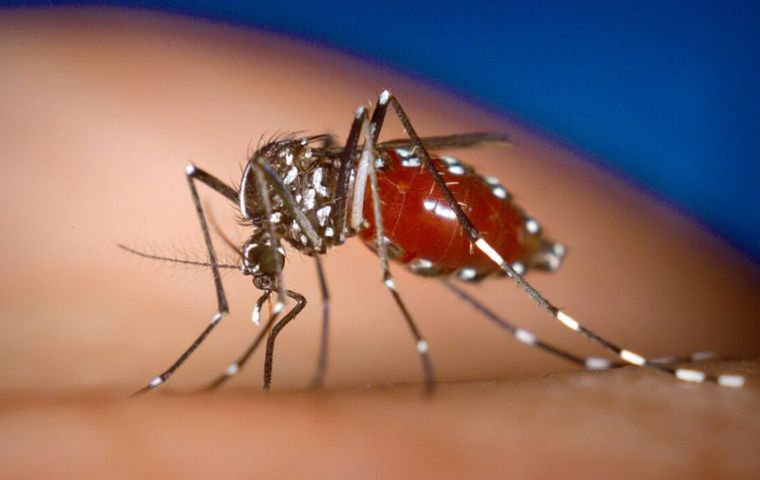MercoPress. South Atlantic News Agency
Oropouche fever expanding beyond Amazonia
 Five people have died so far this year from the disease
Five people have died so far this year from the disease Once a malady associated with Amazonia, Oropouche has spread onto various other Brazilian States, so much so that Espírito Santo, almost 3,000 km away, became the record holder with 6,318 cases.
Researchers are trying to understand what led to this phenomenon, as health officials are devising strategies to control Oropouche among a population with no prior immunity.
This year, Oropouche infections have been confirmed in 18 states plus the Federal District, totaling 11,805 cases. Five people have died from the disease, four in Rio de Janeiro and one in Espírito Santo, with two deaths under investigation.
Virtually every week, this year's cases exceed last year's, and the total for 2025 is expected to exceed the 13,856 recorded in 2024. The number of deaths is already higher. Last year, there were four: two in Bahia, one in Espírito Santo, and one in Santa Catarina.
Oropouche fever is caused by a virus transmitted by the Culicoides paraensis mosquito, better known as maruim or mosquito-pólvora, which is found throughout the country. It causes symptoms similar to those of other mosquito-borne diseases, such as dengue and chikungunya, mainly fever and pain in the head, muscles, and joints.
The infection can also cause complications in pregnancy, including microcephaly, malformations, and fetal death, as can the Zika virus. For this reason, the Health Ministry recommends that pregnant women living in areas with reports of the disease reinforce their protection against mosquitoes. Although sexual transmission has not yet been proven, people with symptoms should also use condoms during sexual intercourse as a preventive measure.
According to Felipe Naveca, head of the Arbovirus and Hemorrhagic Laboratory at the Oswaldo Cruz Institute, genetic studies show that the cases proliferating in Brazil were caused by a new strain of the virus, which emerged in Amazonas, circulated in the North Region, and then spread.
“We were also able to show that this scenario is closely related to some areas of recent deforestation, mainly in southern Amazonas and northern Rondônia, which served as crucial points for the spread of this virus. Infected people ended up taking it outside the region, because after being infected by the virus, it takes a while for symptoms to appear,” Naveca noted.
The maruim mosquito is found throughout the country, but it needs humid environments with decomposing organic matter to reproduce, which is why it is more prevalent in forest and plantation areas, especially banana plantations. Outbreaks have occurred mainly in peri-urban regions, which are transitional areas between rural and forest environments and areas inhabited by humans. Only females transmit the Oropouche fever virus, which can also be inoculated into animals.
According to Naveca, environmental changes also play a role in the spread of the disease. “Every time you have more extreme events, whether drought or flooding, it affects not only the vector population, but also the animals that the mosquito feeds on. So, this changes the entire ecosystem. Our data show that the virus population increased precisely during periods of rain in the Amazon region.”
A recent international study analyzed data from six South American countries, including Brazil, and identified that climatic variables, such as changes in temperature and rainfall patterns, were the main factors influencing the spread of Oropouche, contributing 60%. Therefore, researchers believe that extreme weather events, such as El Niño, likely played a key role in the outbreak that began in 2023.
The Health Ministry has stepped up its monitoring of Oropouche cases and has been holding regular meetings and technical visits to states to advise local authorities on the correct ways to report, investigate, and close suspected cases.
“In partnership with Fiocruz and Embrapa, the ministry is conducting studies on the use of insecticides to control the vector, with promising preliminary results. The evidence supports the definition of strategies to combat the disease, especially during outbreaks, and to reduce its impact on the population. Prevention includes wearing long clothing, closed shoes, fine mesh screens on windows, and eliminating accumulated organic matter,” the Ministry said in a statement.
In addition, Health authorities in Espírito Santo are also on alert, as the small state with just over 4 million inhabitants has become the record holder for cases last year and this year. The State's Undersecretary for Health Surveillance, Orlei Cardoso, explained that most of the 78 municipalities in Espírito Santo have peri-urban characteristics, with many plantation areas, which facilitate the reproduction of the maruim mosquito. With mosquitoes in abundance and a population with no prior immunity, the virus found ideal conditions for spreading.
“We also identified that the first cases occurred during the coffee harvest, which is a period when many people from other states come to work on the farms. This ends up being a favorable time for transmission, especially because workers spend a week in one city, then move on to another...” Cardoso added.
While researchers work to map the areas with the highest incidence of maruim, the secretariat reinforces the training of health professionals.
“As it was an unknown disease, they are now beginning to understand what is happening, so they know how to identify and act on a case of Oropouche. So we are training municipal teams to make clinical diagnoses, mainly to differentiate Oropouche from dengue and other arboviruses, and we are also training community health workers,” the official also pointed out.
Oropouche fever has also become an unwelcome novelty in some states in the Northeast Region, particularly Ceará, which has recorded 674 cases this year. According to the state's Executive Secretary for Health Surveillance, Antonio Lima Neto, cases in Ceará also began in plantation areas, mainly banana, but also cocoa and cassava.
“In the first year, we had 255 cases, which were concentrated in rural districts with small villages, all located in the mountainous region of Ceará, known as Maciço de Baturité. In 2025, when the disease returned, something different happened: it spread to the main city in the region, which is Baturité. Instead of 500 residents, you have 20,000 people,” he further noted.
According to the executive secretary, the state is also investing in clinical management and laboratory surveillance actions to correctly diagnose the disease, especially in pregnant women. Ceará was one of the states that recorded the death of a fetus after the mother was infected with Oropouche. Last year, at least five cases of fetal death and one case of congenital anomaly were recorded in Brazil, caused by the virus.
“The vector control of a domestic mosquito has a central foundation, which is the elimination of breeding sites, as in the case of Aedes Aegypt. You eliminate the places where it reproduces, you renew the water, take care of household waste... With the powder mosquito, you would have to create a chemical barrier between the plantations and the areas where people live. The Ministry of Health has been conducting tests in search of effective products, but it is not a trivial matter,” Lima Neto also underlined. (Source: Agencia Brasil)




Top Comments
Disclaimer & comment rulesCommenting for this story is now closed.
If you have a Facebook account, become a fan and comment on our Facebook Page!